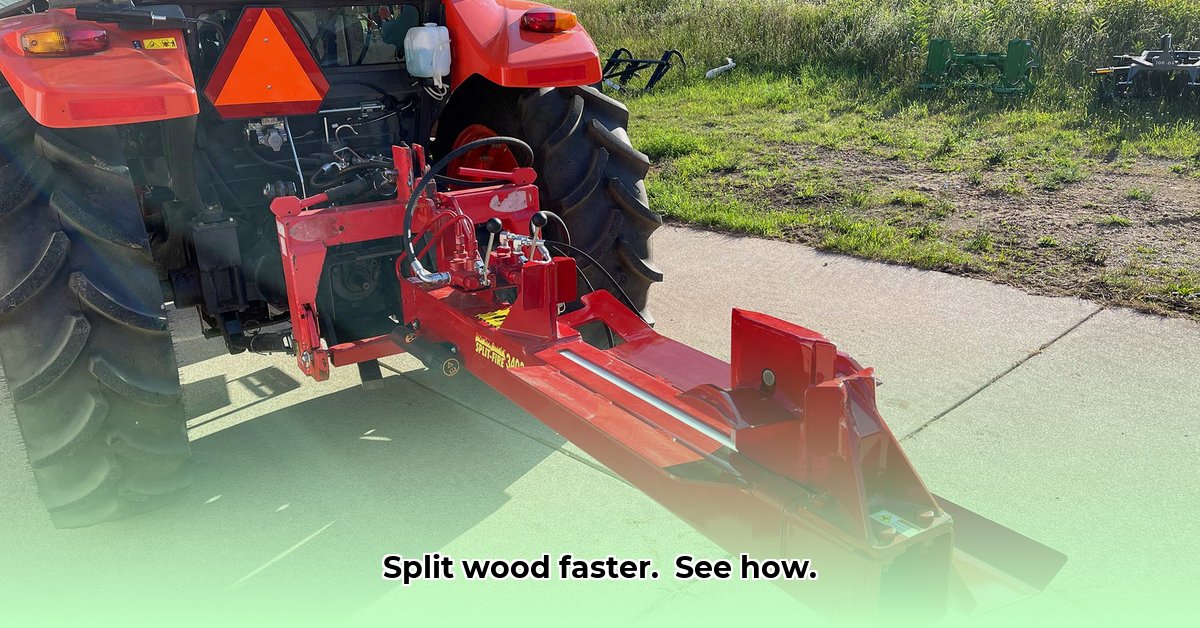
Splitting wood by hand is backbreaking work. But what if you could harness the power of your tractor to make the job faster and easier? This comprehensive guide will equip you with the knowledge to choose and effectively use a tractor-powered log splitter, maximizing your efficiency and saving you valuable time and effort. Whether you're a seasoned woodcutter or a first-timer, we'll walk you through every step of the process.
Understanding Tractor Log Splitters: 3-Point Hitch vs. PTO
Two primary types of tractor log splitters exist: 3-point hitch and PTO (Power Take-Off). Understanding their differences is key to selecting the right one for your needs.
3-Point Hitch Log Splitters: These mount directly onto your tractor's three-point hitch system and utilize your tractor's existing hydraulics. This simplifies setup and integration but makes performance heavily reliant on your tractor's hydraulic capabilities. A weak hydraulic system will result in a slow, inefficient splitter.
PTO Log Splitters: These use a separate hydraulic pump driven by your tractor's PTO shaft. This provides more consistent power regardless of your tractor's hydraulics, making them a reliable option even for older tractors. However, they require a more complex setup process.
Comparing 3-Point Hitch and PTO Splitters:
| Feature | 3-Point Hitch | PTO |
|---|---|---|
| Setup | Simple; direct connection to tractor hydraulics | More complex; involves a separate hydraulic pump. |
| Power | Dependent on tractor's hydraulic system capabilities | Consistent power, less dependent on tractor hydraulics |
| Typical Cost | Generally less expensive upfront | Usually more expensive initially |
| Compatibility | Requires sufficient tractor hydraulic capacity | Requires a functional PTO and adequate engine power |
Is there a noticeable difference in fuel consumption between these types? Research suggests PTO splitters might consume slightly more fuel due to the added hydraulic pump. However, the overall efficiency gain from faster splitting often offsets this difference.
Choosing the Right Tractor Log Splitter: A Step-by-Step Guide
Selecting the ideal log splitter requires careful consideration. Let's break down the process:
Step 1: Assess Your Tractor's Capabilities: Consult your tractor's owner's manual to determine its horsepower (hp), hydraulic flow rate (GPM), and PTO horsepower (if relevant). These figures are essential for ensuring compatibility with different splitters. Mismatching a splitter to your tractor's capabilities can result in poor performance and potential damage.
Step 2: Define Your Needs: How much firewood do you process annually? What are the typical dimensions of the logs you split? These factors determine the necessary splitting force (tons) and log capacity you need. Oversizing can be wasteful; undersizing leads to frustration.
Step 3: Compare Key Features: Consider these critical features when comparing models:
- Splitting Force (Tons): The amount of pressure the splitter exerts. Higher tonnage handles larger logs.
- Cycle Time: The time to split and reset. Faster cycles mean greater efficiency.
- Log Capacity: The maximum log length the splitter can accommodate.
- Safety Features: Prioritize safety features like two-handed controls, automatic wedge return, and sturdy construction.
Step 4: Prioritize Safety: Always wear appropriate safety gear (gloves, eye protection, sturdy boots) and adhere strictly to the manufacturer's safety instructions. Maintain a safe distance from the splitting area, especially keeping children and pets out of the way. Never operate the splitter while fatigued or under the influence of alcohol or drugs.
Safe Operation and Maintenance Procedures
Regular maintenance ensures the longevity and safe operation of your log splitter.
Attachment: Always follow the manufacturer's instructions for attaching the splitter. For 3-point hitches, double-check all pins and locking mechanisms. For PTO models, carefully connect the PTO shaft, verifying alignment to prevent damage.
Operation: Always follow safety guidelines. Maintain a safe distance from the splitting area; never reach into the splitting zone while the machine is active. Never attempt to split logs exceeding the splitter’s rated capacity.
Maintenance: Regularly check hydraulic fluid levels, inspect hoses for leaks, and lubricate moving parts as recommended by the manufacturer. Preventative maintenance significantly extends the log splitter's lifespan. This includes regular inspections for wear and tear on critical components.
Troubleshooting and Repair Guidance
Even with proper care, issues can arise. Here are common problems and solutions:
Slow Cycle Time: This might indicate low hydraulic fluid or a problem with your tractor's hydraulic pump. Check fluid levels first; if the problem persists, seek professional help.
Hydraulic Leaks: Any leak is serious. Immediately shut down the splitter and inspect hoses and connections. Small leaks can quickly escalate, so avoid using the equipment until repairs are made.
Wedge Malfunction: Check for obstructions. If you can't diagnose the issue, seek professional assistance.
Cost-Benefit Analysis: Is a Tractor Log Splitter Worth It?
The initial investment is significant, but the long-term benefits often outweigh the cost. For those who regularly split large quantities of wood, the increased efficiency and time saved can quickly justify the purchase. Consider your yearly firewood needs, the potential cost of hiring help, and the value of your time. For those regularly processing large volumes, the return on investment is considerable.
“The investment in a tractor log splitter pays for itself quickly if you process a significant amount of firewood each year,” advises Dr. Emily Carter, Agricultural Engineering Professor at State University. "The reduction in manual labor and increase in efficiency substantially contribute to its cost-effectiveness."